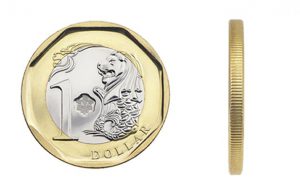For the first lesson, we were asked to bring an interesting 3D object to class for sharing. I was looking around for a special handcrafted sculpture or so, but then I thought maybe I could find a noteworthy everyday object.
So, I turned up with…

Yes, it’s our Singapore’s third series $1 coin.
I thought it was interesting to me because of the shapes it has. On the front surface of the coin, there are 2 circles of a different radius, and also an octagon with it’s edges touching the circumference of the big circle. There is contrast in the shapes in the sense that the circles are edgeless and smooth while the octagon seems rigid and fixed in its shape with its pointed edges. Yet, there is harmony probably due the position of the shapes. 
Turning the cylindrical coin, you can observe little ridges well spaced out and arranged on the outside. One interesting observation from me is that though the ridges may appear to be convex/ protruding out, it is created by the negative space that is concave instead! 
The colours of the coin also helps give the $1 its uniqueness and differentiates the $1 from the other coins right away. There is incorporation of 2 colours: silver and gold. I felt it was interesting that the coin was a bi-metallic composition (outer ring is brass-plated and inner circle is nickel-plate).
As the class went on, we were taught to appreciate objects using the basic concept of Dominant (D), Sub-dominant (SD) and Subordinate (SO).
I guess my object is not exactly a good exhibition of D, SD and SO, but if I try:
Dominant – outer brass-plate
Sub-dominant – engraved Singapore merlion
Subordinate -inner nickel-plate
Learning these concepts really helped me look at things in a different way, and appreciating objects in my everyday life. It also helped me in designing my foam models, keeping these key concepts in mind 🙂
